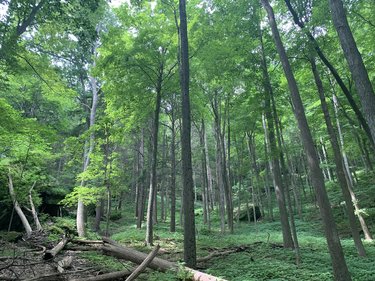Salamanders rejoice: Heldeberg Workshop land added to conservation corridor
NEW SCOTLAND — The Heldeberg Workshop at the foot of the escarpment — where generations of kids have had “adventures in learning” on The Land — will now be protected in perpetuity.
On July 9, the workshop finalized a conservation easement with the Mohawk Hudson Land Conservancy.
The workshop’s 237 acres are now part of a 3,700-acre corridor, stretching from the Black Creek Marsh to John Boyd Thacher State Park.
“It took us almost 10 years, in fits and starts,” said Mark King, conservancy director, of securing the funds for the easement.
The conservancy paid the workshop $200,000, he told The Enterprise.
King went over the patchwork quilt of funding that made purchasing the easement possible. About half of the $200,000 came from the National Fish and Wildlife Foundation — a grant application that was turned down the first time and took several years to achieve.
About $25,000 came from the state. Other support came from The Nature Conservancy and the Open Space Institute.
“And we got a lot of private support from area donors and Heldeberg Workshop alumni,” said King.
The cost for the easement, including tangential expenses is closer to $250,000, he said. “Surveying alone cost $25,000,” King said.
King and his brothers attended summer programs at the workshop as did King’s children a generation later. “It’s a unique experience, based around The Land,” he said. “When I was a kid, some of the founders led an archaeology class; there was nothing else like it. My kids absolutely loved spelunking.”
Workshop classes, which started in Voorheesville’s high school, moved to the Picard Road property in 1967. Workshop programs serve over 1,200 students each summer.
“Not only do we rejoice, but the salamanders and other critters who make this land their home rejoice,” said Al Breisch who chairs the workshops board of directors, in a statement.
For 26 years, until his retirement in 2009, Breisch was New York State’s amphibian and reptile specialist. He studied, catalogued, and worked to preserve the state’s herpetofauna — its amphibians and reptiles, known as “herps.”
He lives at the base of the Helderbergs across the street from the Vly Creek Swamp, a wetlands with a history for scientists.
The amphibian diversity in the area is among the highest in the state, Breisch told The Enterprise in 2017 when he published his award-winning book, “The Snake and the Salamander.” The area has 12 species of salamanders and eight species of frogs and toads.
Salamanders are the most abundant vertebrate in the Northeast, estimated at 14 billion in New York State alone, he said.
“If you pile them altogether, they are more abundant by weight than all the woodland birds put together and about equal to that of all the small mammals,” he said.
Although each salamander is no more than four inches long and many people have never seen one or heard of one, Breisch said, “They are a driving force for the entire food chain. It eats many small invertebrates and is eaten by snakes and robins and turkeys.
Breisch’s book cites studies showing that, without the red-backed salamander to eat decomposers like earthworms, much of the leaf litter on the forest floor would be gone, causing drying and erosion and potentially changing the character of the forest.
“So,” he writes in his book, “the next time you take a hike on a woodland trail, thank a Red-Backed Salamander.”
The corridor
That diversity — of species many are not even aware of — was at the heart of the Mohawk Hudson Land Conservancy’s drive to create the Helderberg Conservation Corridor.
The corridor, including the recent addition of an easement for Picard’s Grove, neighboring the Heldeberg workshop, now encompases scenic open spaces, unique wetlands, and wildlife habitat that would otherwise be fragmented by suburban sprawl.
King notes that conservation efforts began over a century ago with the establishment of Thacher Park in 1914. The modern push for the corridor began after Indian Ladder Farms was protected from development in 2003.
“We realized we preserved an island,” King said of protecting Indian Ladder Farms. So the movement began to, piece by piece, preserve a corridor.
The current corridor, King said, “protects so many ecological, cultural, and historical features.”
He credits people like Breisch and Margaret Craven, who is also on the workshop board, for understanding the importance of the ecology and the need to preserve it.
King said of Craven, who lives at the foot of the escarpment, “She was a major force. She acquired a long-term farm and bought it to preserve the land … She kept encouraging people and educating people.”
King also lauded Peter Ten Eyck, longtime owner of Indian Ladder Farms, as “a visionary that sees the big picture.”
King would like to see the corridor one day stretch all the way to the Catskills. “We will keep chiseling away at it,” he said.
He also said he was excited to see Guilderland’s initiative with a recent state law that will allow residents in that suburban town to apply for tax credits if they want to keep their land from being developed. “A tremendous amount could get done that way,” said King.
Part of Guilderland runs along the base of the escarpment and King said he would be interested in hearing from property owners there.
“A lot in Guilderland wouldn’t meet our criteria,” he said
He said a small organization like his can only do so much, but having towns, like Guilderland and Bethlehem, offering tax breaks for keeping land undeveloped, adds to the overall health of the environment.
Part of President Joe Biden’s climate-change agenda is protecting 30 percent of United States lands and ocean territories by 2030, known as “30 by 30.” Currently, about 26 percent of the United States’ ocean territories are protected but only about 12 percent of the nation’s land area is protected.
The protection is meant to stem climate change since natural landscapes pull carbon dioxide from the atmosphere and store carbon in trees, shrubs, grass, and soil.
King said of the 30-by-30 initiative, “I hope that will open people’s eyes and open new opportunities.”
He concluded, “It’s the people that step up and are supporting — financially but also just by caring — that make these things work … They push others to make things happen.”



